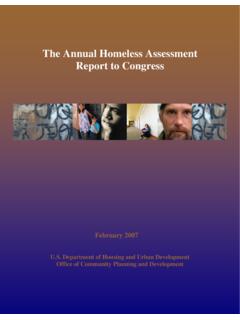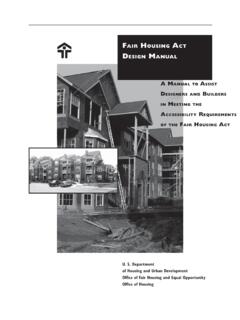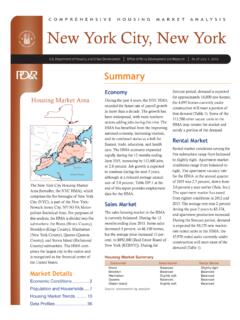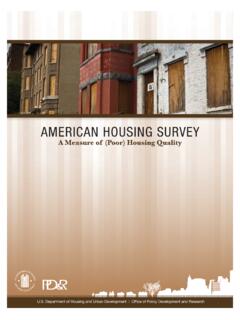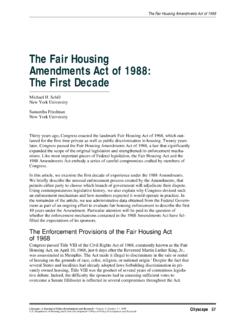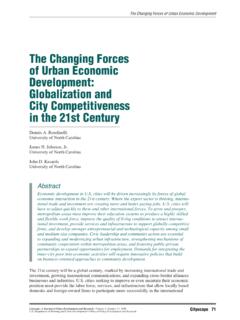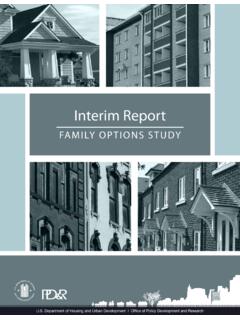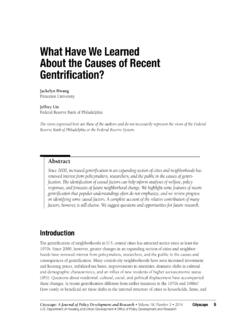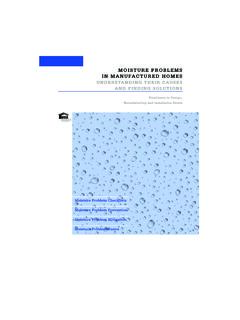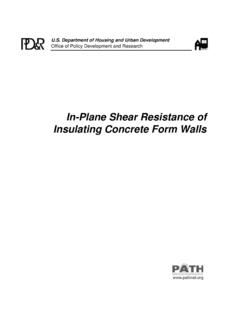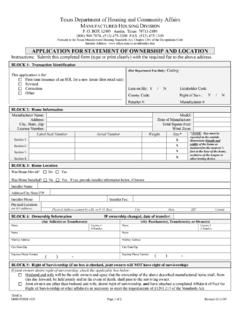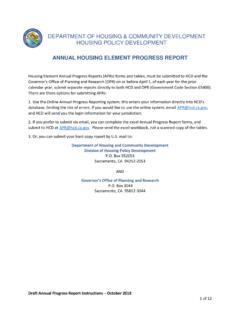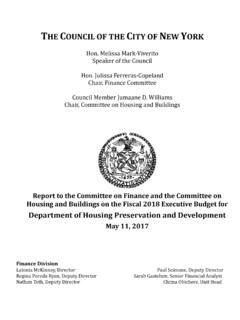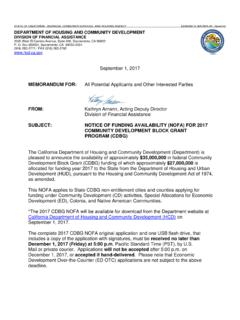Transcription of U. S. Department of Housing and Urban Development
1 U. S. Department of Housing and Urban Development _____ Special Attention of: NOTICE PDR-2017-02 Regional Directors, Field Office Directors, Economists, Public & Indian Housing Issued: April 14, 2017 Division Directors, Multifamily Hub Directors, Expires: Effective until superseded Multifamily Program Center Directors _____ Subject: Transmittal of Fiscal Year (FY) 2017 Income Limits for the Public Housing and Section 8 Programs This notice transmits revisions in the income limits used to define the terms very low-income , low-income and extremely low-income in accordance with Section 3(b)(2) of the United States Housing Act of 1937, as amended. These income limits are listed by dollar amount and family size. Beginning with FY 2010 Income Limits published on May 14, 2010, HUD eliminated its long standing hold harmless policy1 but limited all annual decreases to five percent and all annual increases to the greater of five percent or twice the change in the national median family income (MFI).
2 HUD has maintained these limits to increases and decreases in income limits for FY 2017. For FY 2017 income limits, the national MFI for the United States for FY 2017 is $68,000, an increase of percent compared to the national MFI for FY 2016. Twice this change is greater than five percent, so this higher value is used as the cap on increases, or seven percent. HUD Section 8 Income Limits begin with the production of MFI estimates. HUD uses the Section 8 program s Fair Market Rent (FMR) area definitions in developing MFI estimates, which means that income estimates are developed for each metropolitan area, parts of some metropolitan areas, and each nonmetropolitan county. There were no additional changes to the geographic area definitions from the many changes incorporated in the FY 2016 Medians. HUD Section 8 Income Limits are calculated for every FMR area with adjustments for family size and for areas that have unusually high or low income-to- Housing -cost relationships.
3 1 HUD s hold harmless policy maintained Section 8 income limits for certain areas at previously published levels when reductions would otherwise have resulted from changes in median family income estimates, Housing cost adjustment data, MFI update methodology, income limit methodology, or metropolitan area definitions. 2 The 2010-2014, 5-year American Community Survey (ACS) and Puerto Rico Community Survey (PRCS) income data are the basis of FY 2017 Income Limits for all areas of geography, except for the Virgin Islands and the Pacific Islands. The Consumer Price Index forecast published by the Congressional Budget Office (CBO) is used to bring the ACS data forward from mid-2014 to the mid-point of the fiscal year, April 2017. The median incomes and income limits in the Virgin Islands and the Pacific Islands (Guam, American Samoa and the Northern Marianas) are based on 2010 Decennial Census data which is the most current information available.
4 The decennial data used for the Virgin Islands and the Pacific Islands is trended forward using the change in national MFI between 1999 (which is the year of the income in the decennial census) and the MFI for FY 2017. Public Housing /Section 8 Income Limits are used to determine the income eligibility of applicants for Public Housing , Section 8, and other programs subject to Section 3(b)(2). The revised income limits are based on HUD estimates of MFI for FY 2017. The most important statutory provisions relating to income limits are as follows: - very low-income is defined as 50 percent of the MFI for the area, subject to specified adjustments for areas with unusually high or low incomes relative to Housing costs; - low-income is defined as 80 percent of the MFI for the area, subject to adjustments for areas with unusually high or low incomes or Housing costs; - extremely low-income is defined as an income targeting standard in the 1998 Amendments to the Housing Act of 1937; to avoid inconsistencies with other income limits, it is defined as 60 percent of the four-person family very low-income limit, adjusted for family size.
5 And, under the Consolidated Appropriations Act, 2014, which further amended the Housing Act of 1937, extremely low-income limits are not allowed to fall below the poverty guidelines as determined by the Department of Health and Human Services; - where the area income limit is less than those derived from the state nonmetropolitan MFI, income limits are based on the state nonmetropolitan median; and - income limits are adjusted for family size so that larger families have higher income limits. Very Low-Income Limits: HUD calculates very low-income limits using a set of formulae as follows. The first step in calculating very low-income limits is to determine what they would be if the four-person limit is based on 50 percent of the estimated area median income. Adjustments are then made if this number is outside formula constraints. More specifically, the very low-income limit for a 4-person family is calculated as follows: (1) 50 percent of the area MFI is calculated and tentatively set as the 4-person family income limit; 3 (2) a minimum 4-person income limit is established at the amount required to afford a 2-bedroom unit renting at 85 percent of the 40th percentile rent if 35 percent of income is used for rent (this adjusts income limits upward for areas where rental Housing costs are unusually high in relation to the MFI; (3) a maximum 4-person income limit is calculated as the greater of 80 percent of the MFI or the income needed to afford a 2-bedroom unit renting at 100 percent of the 40th percentile rent if 30 percent of income is used for rent (this adjusts income limits downward for areas with unusually high incomes and relatively moderate rental Housing costs).)
6 (4) in no instance are income limits less than if based on the state nonmetropolitan MFI level (even if the step 2 calculation produces a lower amount); (5) any 4-person income limit that has declined by more than five percent is raised to five percent below last year s income limit and any income limit that has increased more than seven percent is lowered to an increase of seven percent over last year s income limit, the remainder of this decrease/increase to be implemented next year if the underlying data warrant. In any year that twice the national change in median family incomes is greater than five percent, limits will be allowed to increase up to that level if so warranted by the local data. For FY 2017 income limits, twice the increase in the national MFI compared to the FY 2016 MFI is seven percent, so the cap on increases is set at seven percent. Low-Income Limits: Most four-person low-income limits are the greater of: 80 percent of the area MFI, or 80 percent of the state nonmetropolitan MFI level.
7 Because the very low-income limits are not always based on 50 percent of median, however, calculating low-income limits as 80 percent of median would produce anomalies inconsistent with statutory intent ( , very low-income limits could be higher than low-income limits). To eliminate this problem, the normal calculation is to set the four-person low-income limit at ( , 80 percent/50 percent) times the relevant four-person very low-income limit. The two exceptions to this practice are that the resulting 4-person income limit is not allowed to exceed the MFI level ($68,000 for FY 2017) except when justified by high Housing costs; and once adjusted, the four-person low-income limit decrease is limited to five percent or, if increasing, capped at the greater of five percent or twice the national change in MFI (which is seven percent for FY 2017). Use of very low-income limits as a starting point for calculating other income limits has the effect of adjusting low-income limits in areas where the very low-income limits have been adjusted because of unusually high or low Housing -cost-to-income relationships.
8 4 Extremely Low-Income Limits: The Consolidated Appropriations Act, 2014, amended Sec. 238. (a) Section 3(b) of the United States Housing Act of 1937 (42 1437a) as follows: (C) The term extremely low-income families means very low-income families whose incomes do not exceed the higher of (i) The poverty guidelines updated periodically by the Department of Health and Human Services under the authority of section 673(2) of the Community Services Block Grant Act applicable to a family of the size involved (except that this clause shall not apply in the case of public Housing agencies or projects located in Puerto Rico or any other territory or possession of the United States); or (ii) 30 percent of the median family income for the area, as determined by the Secretary, with adjustments for smaller and larger families (except that the Secretary may establish income ceilings higher or lower than 30 percent of the median for the area on the basis of the Secretary s finding that such variations are necessary because of unusually high or low family incomes).
9 HUD calculated the extremely low-income limits for all areas in the using the 2017 Poverty Guidelines for the 48 contiguous states and the District of Columbia (Lower-48 States), for Alaska and for Hawaii. These poverty guidelines were published in the Federal Register by HHS on January 31, 2017. Family Size Adjustments: By statute, family size adjustments are required to provide higher income limits for larger families and lower income limits for smaller families. The factors used are as follows: Number of Persons in Family and Percentage Adjustments 1 2 3 4 5 6 7 8 70% 80% 90% Base 108% 116% 124% 132% 5 Income limits for families with more than 8 persons are not included in the printed lists because of space limitations. For each person in excess of 8, the income limit for such households is computed by adding an additional eight percent to the 4-person base.
10 The 9-person income limit, for example, is set at 140 (132 + 8) percent of the relevant four-person income limit. Local agencies may round income limits for 9 or more persons to the nearest $50, or may use the un-rounded numbers. Family size-adjusted income limits are not re-tested for compliance with the cap and floor rule. Rounding anomalies produce some family size-adjusted income limits whose annual change is slightly larger or smaller than five percent change in the floor and the seven percent change in the cap allowed for FY 2017. FY 2017 income limits are available in multiple formats and available at Questions related to how these income limits apply to the programs of state and other federal agencies should be referred to those agencies. Questions concerning the methodology used to develop these income limits are addressed in the FY 2017 Income Limits Briefing Material, which is posted on the income limits website. _____/s/_____ _____/s/_____ Genger Charles Jemine A.
